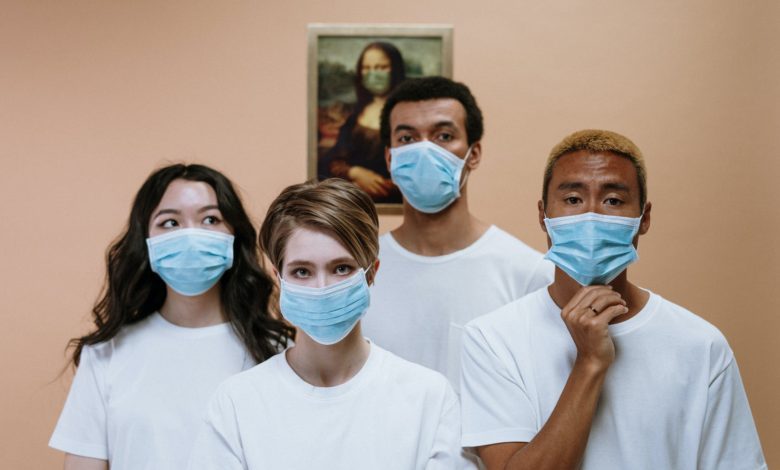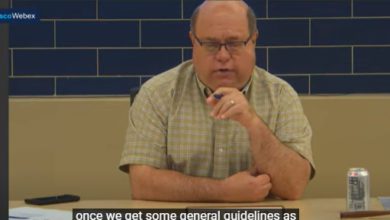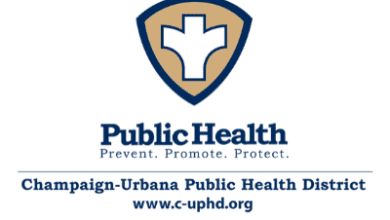The importance of social distancing during Phase 3

By Dani Tietz
dani@mahometnews.com
There is still a lot to be learned about COVID-19. But as Illinois begins to reopen in Phase 3 of the Restore Illinois plan, one thing is for certain, COVID-19 is still prevalent.
“We don’t have a vaccine or a medication that for sure will treat COVID-19, so I think even though we’re going to be moving into this next phase and things are going to be opening up, we still really need to be social distancing as far as trying to stay six feet from other people,” Christie Clinic’s Dr. Jeanelle Murphy said.
While Phase 3 guidance provided by the Illinois Department of Public Health allows for gatherings of fewer than 10 people, Murphy said that it is still important for people to remember that they should stay within their family groups. If they choose to expand that group, they need to wear a mask when not six-feet apart.
“Even though we’re opening back up and the numbers are slowing, they’re still there; we’re still getting a bunch of new cases every day,” she said. “So, we’re still at risk. I feel like we definitely cannot go out and just act like everything’s fine and the virus is gone.”
Summer allows for opportunities that the colder months do not. Restaurants will be able to host outdoor seating, parks remain open and farmers markets are popping up here and there.
Murphy said outdoor gatherings, like barbecues, run a lower risk of COVID-19 transmission than indoor gatherings do.
“The virus definitely spreads easier inside than it does outside,” Murphy said. “So probably a little bit less of a concern if you’re getting together at a park than if you’re getting together inside somebody’s home. I think gathering outside would be much more preferred at this point.
“And again, if you’re not going to wear a mask then trying to stay six feet away from people that do not live in your home that is still the case even with these gatherings.”
This is important because 35-percent of people with COVID-19 do not show symptoms of having the virus. Murphy said even in two-person gatherings, if one is infected and transmits the virus to another person, that person could then transmit it to 2.5 to 3 people.
When meeting face-to-face with someone outside the home, Murphy best practice is to wear a mask.
Research has shown, though, that not all masks are created equal. The best mask for non-medical professionals is one made of multiple layers, preferably one silk and one cotton layer.
“As far as we know, COVID-19 is transmitted via droplets,” Murphy said. “And droplets are larger and they’re spread when somebody is coughing or sneezing, somewhat when they’re talking as well. So a mask, even a cotton mask is going to catch a majority of droplets.
“(The mask) is going to help when that person is talking; it’s going to help prevent the other person from inhaling in the droplets and therefore getting the virus.”
But what is unknown at this point is if the virus can be transmitted through aerosol droplets, tiny respiratory droplets that can remain suspended in the air.
“Cotton and silk together is very effective,” Murphy said. “That’s going to significantly decrease transmission, even for aerosol.”
Murphy said that “in an ideal world, we would not be opening up yet because there is still a virus out there” but looking at the whole picture including the economic impact is also important.
Reports of depression and anxiety are on the rise as business owners grasp with the reality of closing their doors and adults, who have never had to file for unemployment, have had to do so within the last two months.
Those who have never struggled with mental health issues may be now.
Murphy said a change in personality: someone who is usually outgoing becoming withdrawn, loss of appetite, confusion or extreme anxiety, such as cleaning all the time, are characteristics that may signal someone needs additional help.
“Doctors are open, family doctors are open, pediatricians are open,” she said. “You can definitely call and get advice. Counselors are offering telehealth and phone visits right now.”
The Illinois Department of Human Services has also set up a text line (to help those struggling with with stress related to the COVID-19 pandemic. To access that line text TALK or HABLAR to 552020.
People seeking assistance will remain anonymous and will provide only their first name and zip code, which enables the service to link you to a counselor in your area who is knowledgeable about available local resources.
Murphy said that if a loved one has suicidal thoughts, they need to get immediate help at the ER.
She added that people should continue to feel comfortable seeking routine medical care, including vaccinations, and if they have an emergency, they should seek help in the ER.
“I feel like so many people have been kind of ignoring symptoms that they shouldn’t be because they’re afraid of the virus,” she said. “People still need to get medical care like always, we just call it head first.”
Being cognizant of the need to restart the economy, Murphy said that it’s important to go slowly.
“We should not go crazy, which is why Illinois has done it in phases,” Murphy said. “We’re not just going to all of a sudden open up school and open up the churches and open up restaurants, because that would be catastrophic.
“We’re going into the next phase where we’re going to open up businesses that were previously closed. We’re going to be allowing some get togethers with people outside of your home.
“The virus is still there and if we go crazy and we do not socially distance and we take off our masks, if we just forget about the virus, then it’s going to explode again. And we’re going to have to close again, because we do not have a vaccine and we do not have a medication that’s readily available and that works well.”
Still mitigating the impact on hospitals so everyone can continue to get adequate medical care is the goal.
Pritzker set up the Restore Illinois plan to move forward and backwards based on five metrics: positivity rate less than 20%, percent change in positivity rate, percent change hospital admissions, medical/surgical beds available, ICU beds available and ventilators available.
The medical advice all along has been to socially distance and wash your hands with soap and water for 20 seconds or use hand sanitizer regularly.
The addition of wearing a mask was not a change in direction, but rather scientists learning more about how the virus is spread and what people can do to protect one another.
As medical professionals continue to learn more about COVID-19, a novel (new) virus, they are also trying to provide guidelines and information to the public in a responsible manner.”
Murphy said it is still important for people to trust the scientific community, including the CDC.
“We didn’t even know that wearing a face mask for the general public was going to be helpful,” she said. “Originally, the CDC didn’t think that we should wear masks, but then they completely changed that because it was found out that 35% of people don’t even have symptoms.
“So certainly having everybody wear a mask could potentially prevent a significant spread.It’s normal in science to change your mind as you learn more and that’s a good thing.”
A week ago, the CDC reiterated their findings that coronavirus does not ‘spread easily’ from touching surfaces or objects. Murphy said that medical professionals have known that the virus can live on surfaces, including plastic and metal for days.
“But what we don’t know is even though the virus is present will cause infection,” she said. “We don’t know that.
“The CDC really didn’t change their mind on that they’re just saying,” Murphy said. “(Touching surfaces is) not the main way that it’s spread. Can it spread from surfaces Yes, but we don’t really know to what extent.
“It could be a dead virus; we just don’t know yet. So that’s the problem with this virus is that there so many things we still don’t know at this point.”
Like the CDC, Murphy still suggests that people wash their hands frequently and do not touch their eyes, nose or mouth. She also said that people with immunodeficiencies might want to wipe down their containers with Clorox wipes as an added precaution.
“Again that’s not the main way that it spreads so it’s a lot less likely someone’s going to get COVID-19 from their groceries, they’re much more likely to get it from somebody that is in the store,” she said.
Researchers are also looking into if the virus may or may not spread through fecal matter. At this time, it does not appear that COVID-19 can be spread through the shedding of fecal matter through untreated water, like in a lake or river.
Murphy said that people are more likely to become infected with COVID-19 by being in close contact with an infected person.
“In other states pools are open,” she said. “If people decide to go to pools, they’re probably pretty safe in the water, as long as they stay six feet away from other people who are not living with them.”
As gyms reopen, visitors should also be cognizant of how close they are to other people working out. Gyms are allowed to hold outdoor sessions with no more than 10 people or one-on-one training in Phase 3. Murphy said that if while working out, a six-foot distance cannot be maintained, then a mask needs to be worn.
“Obviously when you’re wearing a mask you’re more likely to get short of breath, you’re not going to be able to exercise the way that you normally would because you are going to run out of breath faster,” she said.
“There’s different symptoms to watch out for like feeling dizzy or feeling overly short of breath, you need to stop. And, if necessary, take off your mask and take a break.
“If you can exercise outside and you can stay six feet away from people that are not living in your household, you don’t have to wear a mask.”
Murphy said it will probably take a full year of watching COVID-19 to fully understand how it acts during different seasons. Medical professionals do understand some about COVID-19 from its predecessors SARS and MERS, which have been around for nearly 20 years.
One aspect that doctors won’t have the answers for soon are the long term effects that COVID-19 has on the body.
With 5.8 million cases worldwide, including 1.7 million in the United States, according to John Hopkins University, Murphy continues to said people still need to be very cautious and remember that COVID-19 is still prevalent.
“Even though it’s opening up I think people still need to take it and follow all recommendations,” she said.
That recommendation extends to other states where guidelines may be different.
“If you go to another state and you’re not socially distancing there, and you pick it up, then come back here, that’s another case here, and then you’re going to spread it to three more people here.
“Still socially distance, six feet away from people, still wash your hands a lot and still wear a mask.
“I still think it’s important to follow the overall rules, and until we have a vaccine or a good treatment we just need to be careful.”




